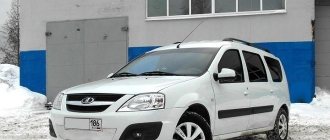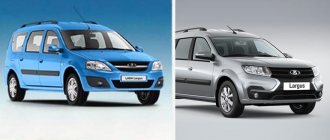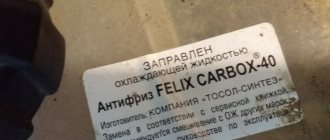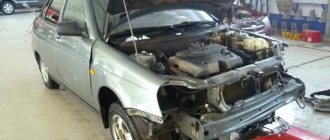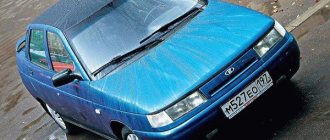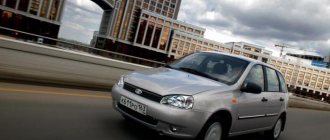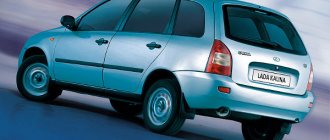This is the Lada model
The Lada Kalina station wagon (factory code VAZ 1117) appeared on the country's roads in early 2007. This car was developed on the basis of the VAZ 1118 sedan, which entered the market 3 years earlier. Like all cars of this model range, Kalina 1117 was created for intensive driving in urban conditions and, depending on the configuration, was equipped with 2 different injection engines, which provided the car with excellent dynamics. Despite similar speed and technical characteristics, the station wagon had a number of advantages compared to a hatchback car. Firstly, it was 19 centimeters longer, which significantly improved the comfort of rear seat passengers and increased the volume of cargo carried. Secondly, the station wagon’s ground clearance is 2.5 cm higher, which ensures better cross-country ability on snowy and dirt roads.
During the production process, the machine was constantly modernized. In 2010, buyers were surprised by the new interior design. In 2011, the car began to comply with EURO 4 environmental standards and received an electronic gas pedal. But despite constant updates, in the spring of 2013 the 1st generation station wagon was discontinued.
Technical characteristics of Kalina station wagon
| Engines | 1.6 l, 8 cells | 1.4 l, 16 cells |
| Length, mm | 4040 | 4040 |
| Width, mm | 1700 | 1700 |
| Height, mm | 1500 | 1500 |
| Base, mm | 2470 | 2470 |
| Front wheel track, mm | 1430 | 1430 |
| Rear wheel track, mm | 1410 | 1410 |
| Luggage compartment volume, dm 3 | 350/650 | 350/650 |
| Weight in running order, kg | 1080 | 1080 |
| Gross vehicle weight, kg | 1555 | 1555 |
| Permissible total weight of a towed trailer with brakes, kg | 900 | 900 |
| Permissible total weight of the lettered trailer without brakes, kg | 450 | 450 |
| Wheel formula/drive wheels | 4x2/front | 4x2/front |
| Car layout diagram | front-wheel drive, front engine, transverse | |
| Body type/number of doors | station wagon/5 | station wagon/5 |
| engine's type | gasoline, four-stroke | gasoline, four-stroke |
| Supply system | Electronically controlled distributed injection | |
| Number and arrangement of cylinders | 4, in-line | 4, in-line |
| Engine displacement, cm 3 | 1596 | 1390 |
| Maximum power, kW/rpm | 59,5 / 5250 | 65,5 / 5250 |
| Maximum torque, Nm at rpm | 120 / 2500-2900 | 127 / 4200-4800 |
| Fuel | unleaded gasoline AI-95 (min) | unleaded gasoline AI-95 (min) |
| Fuel consumption by driving cycle, l/100 km | 7,8 | 7,0 |
| Maximum speed, km/h | 160 | 165 |
| Transmission | With manual control | With manual control |
| Number of gears | 5 forward, 1 reverse | 5 forward, 1 reverse |
| Main gear ratio | 3,7 | 3,7 |
| Steering | with electromechanical amplifier, rack and pinion steering mechanism | |
| Tires | 175/65 K 14 (82,N); 185/60 K14 (82,N) | 175/65 K 14 (82,N); 185/60 K14 (82,N) |
| Fuel tank capacity | 50 | 50 |
Test drive Lada Kalina - Universal version (Kalina 1.4; 1.6)
“Lada Kalina” with a new body
Sales of the Lada Kalina station wagon have begun. The car received not only a new body. The chassis of the vehicle has changed somewhat, and the list of additional equipment has expanded.
AvtoVAZ CONSTRUCTORS did not change the overall dimensions of the car - for the new version of Kalina they are the same as for the usual sedan.
Due to the fact that the length of the car has remained unchanged, the trunk volume (the main thing for which station wagons are valued), let’s say, is not impressive. Still, 350 liters (when loaded up to the window line) is not the best figure by modern standards. Competitors that are similar in size have more impressive cargo compartment capacity. Moreover, in this parameter, the Kalina station wagon is not much ahead of the hatchback, whose trunk volume is 235 liters, but is inferior to the sedan (400 liters). At the same time, the carrying capacity of any modification of the Kalina, regardless of body type, is 475 kg.
Of course, the rear seats can be folded (in a ratio of 1:3), and then the trunk volume will increase to 650 liters. However, on other compact class station wagons this figure comes close and sometimes exceeds 1,000 hp.
However, two or three travel bags will fit here comfortably. Another thing is that it is not very convenient to load luggage - the lower edge of the trunk door opening is located quite high. But for securing things in the cargo compartment there are several metal loops.
Watch your back!
TO GET acquainted with the car, Togliatti residents laid out a driving route through the whole of Kazakhstan - from north to south. In the vicinity of Almaty, the heat is 30 degrees, and in the cabin of the Kalina, pleasant cool air blows from the deflectors. Conventional air conditioners are no longer uncommon on domestic cars. They are installed on “Samara”, and “Priors”, and on “Volga”. But climate control is still a novelty for our automakers. “Lada Kalina” in the “Lux” configuration is actually the first production Russian car equipped with this device. True, the algorithm for its operation is not entirely clear - the deflectors alternately emits arctic cold and desert heat.
Climate control, soft seats, good ergonomics... It would seem, what more could you want? However, after a long trip in the second row of seats, my back ached all night. The point is not at all in shaking and not in the quality of Kazakh roads (they, by the way, are quite decent, with the exception of the 150-kilometer stretch between Balkhash and Alma-Ata). Just so that when folding out the rear sofa you don’t “lose” the seat belt buckles, plastic latches are built into the back of the chair. They are located exactly opposite the lower back - you want to lean back in a chair, but hard plastic digs into your back.
With the exception of this fastener, there are no other comments regarding comfort in the passenger seats. Thanks to the high body, there is quite a lot of headroom. Despite the relatively small external dimensions, the rear passengers will not feel cramped, even if a tall driver or passenger is sitting in front: there is enough legroom.
old friend
FOR THE TEST, the organizers prepared cars equipped with an 81-horsepower 1.6-liter engine. This motor has been installed on the Kalina from the very beginning of its production and is already well known. You can't expect any new impressions from him.
However, it feels like a station wagon with this engine accelerates a little slower than a sedan or hatchback. The reason lies in the new settings (this engine meets Euro-3 requirements, and before we drove Kalinas with a Euro-2 engine), as well as in the increased weight of the car. After all, a station wagon is 30 kg heavier than a hatchback and sedan...
Due to the increased weight of the car, the designers had to use stiffer springs and shock absorbers. This had a beneficial effect on the handling of the Kalina: the car became more collected and rolls less in turns. True, on a rough road passengers shake a little more than in other modifications. Another thing would be to change the settings of the steering mechanism so that the steering wheel would not be so “empty” and uninformative - and one could say that on the road the Lada Kalina is practically in no way inferior to its foreign counterparts...
There is progress in the quality of car assembly. The Kalina I drove last fall in Karelia was annoying with the glove box constantly opening on bumps and vibrating mirrors. Now such sins have not been observed with the car. However, by the end of our run, a dozen and a half “crickets” started up in the station wagon’s interior...
350 liters is not the most impressive trunk volume for a compact class station wagon.
| Brief technical characteristics of “Lada Kalina” station wagon | ||
| 1.4 | 1.6 | |
| Overall dimensions, cm | 404x170x150 | |
| Curb weight, kg | 1.110 | |
| Engine | 4-cyl., 16-valve, 1,390 cc. cm | 4-cyl., 8-valve, 1,596 cc. cm |
| Power | 90 hp at 5.250 rpm | 81 hp at 5,200 rpm |
| Torque | 127 Nm at 4,200-4,800 rpm | 120 Nm at 2,500-2,900 rpm |
| Transmission | 5-speed, mechanical | |
| type of drive | front | |
| Maximum speed, km/h | 165 | 160 |
| Acceleration 0-100 km/h, s | 12,2 | 13,5 |
| Average fuel consumption, l/100 km | 7 | 7,8 |
| Fuel capacity, l | 50 | |
Author Kirill SAZONOV Edition Klaxon No. 10 2008 Photo photo of the author and AvtoVAZ
www.motorpage.ru
Description of the car
The Lada Kalina station wagon fully lives up to its name.
Many Russians have already been able to see the versatility of this iron horse. By the way, it is already clear that this car is mainly purchased by people who prefer active recreation. Thanks to its functional features, this five-door car is an ideal option for country trips. Russian developers knew that their product would have to overcome domestic roads! That is why they endowed the Lada Kalina with high cross-country ability and maneuverability, which allows it to easily overcome both city highways and dirt roads.
In addition, the VAZ 1117 Kalina station wagon has a refined and at the same time democratic design of the body and interior, which makes it an ideal option for a family car. Travel comfort is ensured for every family member, thanks to the wide adjustment of the front seats, which allows you to free up space for luggage. And for large items there is an almost (slightly short of a sedan) universal trunk, convenient for trips to the country. But, if you remove the rear parcel shelf, the trunk capacity increases to 500 liters, which, of course, makes the Lada Kalina station wagon beyond any competition.
In addition, the new Lada Kalina station wagon is equipped with a climate control system, effective ABS and many other innovations that were previously rare in the automotive market.
In its technical characteristics, the Lada Kalina station wagon is not inferior to the sedan. The machine is equipped with a four-cylinder engine with a distributed electronic fuel injection system. Classic convenience is provided by a five-speed manual transmission.
In general, the fact that Ladas are becoming more and more common on the roads speaks for itself. After all, the Lada Kalina station wagon went on sale three years ago. Consumers throughout Russia were able to see the advantages of this car. In addition, the Kalina station wagon, thanks to its design solution, has acquired presentability and visual appeal. The rounded lines of the car's silhouette now speak more about its maneuverability and ease of control. Indeed, people of the older generation feel comfortable behind the wheel; they easily feel the ease of contact with the road surface.
We're sorry, but the requests coming from your IP address appear to be automated. For this reason, we are forced to temporarily block access to the site.
To continue, please enter the characters from the image in the input field and click "Submit".
Cookies are disabled in your browser
. We will not be able to remember you and correctly identify you in the future. To enable cookies, follow the tips on this page.
Lada Kalina trunk volume station wagon and hatchback:
The useful trunk volume of the Lada Kalina hatchback and Lada Kalina station wagon models was calculated and designed by the developers in accordance with the standards specific to this class. Let us remind you that the practical “Kalina” belongs to the so-called budget segment, and therefore the luggage compartment here should be as convenient as possible in terms of loading and quite spacious. These two factors are of paramount importance, because the model we are considering is used by a very large army of owners.
We will learn from our material how much this manufacturer’s doctrine is reflected in reality.
Luggage compartments of Kalina
The Lada Kalina station wagon of the second generation has a good advantage, expressed in the ability to quickly and easily transform the luggage compartment to a much larger capacity. In the standard state, the usable space of this body version is 355 liters, which in comparison with the hatchback looks decent, because the trunk volume of the latter reaches only 240 liters. In the universal variation, the developers managed to very competently plan the luggage compartment, despite the modest overall parameters of the body.
For example, in a sedan the trunk volume in the standard state is larger and reaches 400 liters. However, if you fold the backs of the rear seat row in a station wagon, the useful volume for luggage increases to 670 liters, which is 120 liters more compared to performing a similar manipulation with the seats of the Lada Kalina hatchback.
Here you can see that the station wagon is the record holder among the family of Kalina modifications in terms of space available in the trunk, which should be taken into account by owners who pursue such an indicator as capacity as one of their main goals. Despite the modest length of the car (about 4 meters), the size and dimensions of the station wagon trunk can allow the owner to transport luggage of different sizes.
Comparing models
Since the truth can be born in the process of comparison, further in our review we should indulge in drawing some parallels. When starting a conversation about Kalina in the newer generation, it should be noted that in terms of the volume of space in the trunk, the hatchback is not able to impress with the impressive volume of the compartment. The Lada Kalina station wagon turned out to be much more spacious, where the developers tried to make it as spacious as possible in order to be able to compete with its classmates in the subcompact segment.
Let us remind you that the hatchback has a luggage volume of a modest 240 liters. This figure was determined by the manufacturer taking into account the space up to the rear parcel shelf. When the need arises to increase the volume, the designated shelf can be dismantled with your own hands. This helps when transporting large luggage. If the owners are not satisfied with this situation, then the luggage compartment is transformed by folding the backrests, and the dimensions and dimensions of the luggage compartment are 550 liters.
There is a category of owners who, due to their occupation, need to transport larger items. Here we recommend taking a closer look at the station wagon, because in terms of free space in the trunk, this body modification holds sole leadership. Its 670 liters of volume will be quite enough to satisfy the needs of even the most picky owners.
How much does the new Lada Granta cost?
Grant armrest
Steering rack Lada Granta
If the future owner of Kalina prefers a hatchback, then it makes sense to consider in more detail the capabilities of its trunk, and how much it will lose to a station wagon, what dimensions and dimensions of the trunk it has. We arm ourselves with a tape measure and begin to measure the sizes of openings, lengths and heights that interest us.
- The height of the compartment reaches 82 cm (to the ceiling), and to the shelf level - 49.2 cm.
- The depth of the trunk with the rear row folded is 131.9 cm, and the distance from the same starting point of the compartment to the front panel is characterized by 220 cm. With the row not folded, the depth is 64.4 cm.
- We denote the width inside the compartment by two parameters: between the wheel arches - 947 cm and between the rear wings (in front of the arches) - 127.7 cm.
- Having succumbed to simple calculations, we determine that the maximum possible volume of space has reached approximately 1 m³, which in terms of liters is 1000 units. The manufacturer notes this value at 550 liters, but it can be loaded to the ceiling.
About possible problems
Purchasing a car often involves some risks. Often the future owner has to carry out certain types of modifications. Regarding the Lada Kalina hatchback, the trunk lock appears as a weak point. Repairing it is not difficult, and replacement is not an expensive undertaking, but there are many complaints, so we could not “pass” this aspect.
Manufacturer bonuses
Most owners are inclined to believe that Kalina’s universal body is the most successful and balanced compared to other body modifications. This is echoed by a number of undeniable advantages:
- exterior design that many car enthusiasts find worthy;
- capacity of the luggage compartment with a pleasant and useful option - the ability to fold the backrests of the rear row;
- maintainability and reasonable maintenance costs.
Let's sum it up
An important point that deserves special attention is the manufacturer’s pricing policy. This allows the station wagon considered here to win the sympathy of a large category of buyers. This car has a balanced set of consumer qualities, including such an important and practical indicator as the capacity of the luggage compartment. The correct approach of the manufacturer is the key to the success of the model or its specific modification in the market space.
vaz-lada-granta.com
Why did it happen so?
Perhaps the automatic requests do not belong to you, but to another user accessing the network from the same IP address as you. You need to enter the characters into the form once, after which we will remember you and be able to distinguish you from other users exiting from this IP. In this case, the page with the captcha will not bother you for quite a long time.
You may have add-ons installed in your browser that can make automatic search requests. In this case, we recommend that you disable them.
It is also possible that your computer is infected with a virus program that is using it to collect information. Maybe you should check your system for viruses.
If you have any problems or would like our support team, please use the feedback form.
This is the Lada model
The Lada Kalina station wagon (factory code VAZ 1117) appeared on the country's roads in early 2007. This car was developed on the basis of the VAZ 1118 sedan, which entered the market 3 years earlier. Like all cars of this model range, Kalina 1117 was created for intensive driving in urban conditions and, depending on the configuration, was equipped with 2 different injection engines, which provided the car with excellent dynamics. Despite similar speed and technical characteristics, the station wagon had a number of advantages compared to a hatchback car. Firstly, it was 19 centimeters longer, which significantly improved the comfort of rear seat passengers and increased the volume of cargo carried. Secondly, the station wagon’s ground clearance is 2.5 cm higher, which ensures better cross-country ability on snowy and dirt roads.
During the production process, the machine was constantly modernized. In 2010, buyers were surprised by the new interior design. In 2011, the car began to comply with EURO 4 environmental standards and received an electronic gas pedal. But despite constant updates, in the spring of 2013 the 1st generation station wagon was discontinued.
Body
The body of the Lada Kalina car has 4 or 5 doors, depending on its type: sedan or station wagon, respectively. The sizes are also slightly different. For example, the station wagon has a length of 4084 mm, which is 40 mm longer than the sedan body. The width and height, on the contrary, are absolutely the same: 1700 mm and 1500 mm, respectively.
Since the Lada Kalina sedan and station wagon are built on the same model, the wheelbase dimensions are absolutely identical. The difference may be clearance. The sedan body has slightly more ground clearance than the cargo version. This is due to the fact that the luggage compartment is designed differently and the weight that falls on the rear axle is also not distributed equally. For example, the trunk of a VAZ sedan is smaller in size and located at the rear, resting entirely on the rear axle. But the station wagon has a longer luggage compartment, which allows part of the load to be transferred to the front axle.
The trunk volume is very different for different body types of Lada Kalina. The sedan has a volume of 400 liters, while the station wagon has 670. This allows you to take on more weight, at which the ground clearance will not decrease significantly.
Factory wheel size can vary from R13 to R14. Depending on which wheels will be installed on the VAZ Kalina, the ground clearance will also depend. But at the same time, there will be one drawback: if you load a lot of weight into the trunk, the wheels will rub against the arch.
The maximum carrying capacity of the Lada Kalina station wagon is 400 kg, and the sedan is 200. The weight of the car without passengers is 1160 kg and 1080 kg, respectively.
Vehicle configuration
Inside the car
The Lada Kalina family was created on the VAZ 2108 platform. The progenitor of the new model received a significantly redesigned chassis, as well as the layout of the power unit and transmission. The angular shapes completely disappeared from the exterior; in general, it could be called modern and inviting. All hard plastic parts have been removed from the interior. The panels became soft and warm, this was especially noticeable in cars produced in 2010-2013. In general, a description of all the changes that the mother platform has undergone can take several pages, so let’s note the main thing: the car has become many times more convenient and safer than the Lada Samara.
From the very beginning of production, the station wagon was offered in 2 trim levels:
The first configuration had the following set of free options.
The luxury version, in addition to everything described above, was additionally equipped with air conditioning and an anti-lock braking system (ABS).
Presentation of the car at the factory
The cost of the top version without ABS in 2013 was 360,000 rubles. For an additional fee, it was possible to install front airbags, foglights and heated front seats. The price of such a package of options was from 25,000 rubles.
Since 2007, the Lada Kalina has been equipped with 2 naturally aspirated gasoline engines:
Depending on the model of the power unit, the station wagon was designated as Kalina 11173 or Kalina 11174. It is important to note that the 8-valve engine was installed only on cars in the “norm” configuration. The 16-valve engine was mainly installed on cars of the “luxury” configuration, but for an additional fee it could also be installed on the Kalina “norm”.
Characteristics of VAZ Kalina
Technical characteristics of VAZ Kalina. Find out the dimensions, fuel consumption of the VAZ Kalina, features of engines, suspensions, bodies and other technical characteristics of VAZ Kalina cars.
Select VAZ Kalina model:
Answers
History of VAZ Kalina
VAZ Kalina is a modern class B car. Each body type has its own index: sedan (1118), five-door hatchback (1119), station wagon (1117). The first in the Kalina family was a sedan, launched into production in November 2004. Smooth body contours, a wedge-shaped front end, flat sidewalls and original, efficient lighting technology give the car a modern, elegant appearance. The disproportionately high body is the price to pay for 160 mm of ground clearance. The door opening angle is almost 90 degrees. This ensures ease of fit. Having a slightly shorter length compared to cars of the SAMARA and VAZ 110 family, the Kalina model is more maneuverable and better adapted to driving conditions in an urban environment.
Advantages and disadvantages of a station wagon
According to the manufacturer, the Lada Kalina 111730 is the most widely used. The technical features of this modification of the car best meet the “price-quality” criterion.
Customer reviews indicate that the station wagon has both pros and cons.
New model Cross 2014
Negative features of the model.
Technical characteristics and dimensions of Lada Kalina 111730:
Lada Kalina is a fairly liquid car. You will not lose money when selling it on the secondary market. Young people love this car very much. In addition, tuning a car is a real pleasure.
Comparison of different generations of Lada Kalina
The main and most obvious difference is the appearance. After restyling, Kalina received a new massive bumper in a modern design. The optics of the headlights have also changed, which is now complemented by daytime running lights. By the way, when the car was presented at the Moscow Motor Show, the DRLs were LED, but they are no longer available in the production model.
Changes are also visible from the side, and they are mainly caused by the bumpers. If the front one turned out to be massive, then the rear one, on the contrary, is small. The taillights have changed slightly in shape, and now part of them extends more to the side. The changes are also noticeable when looking at the rear headlight unit: they have become much larger and look more interesting than on the first generation station wagon.
Changes in the cabin
The interior has changed significantly after the change of generations. The developers began to use a completely different dashboard and a different instrument panel. There is no trace left of the first generation design. Controls for a modern climate control system have appeared. Depending on the configuration, a multimedia system with a touch screen can be installed. The display is located at the top and is covered with a special visor that prevents glare in bright sunlight. All controls are placed in separate blocks. The side air ducts are Granta style, but the center console uses rectangular vents.
Separately, it is worth mentioning the seats, which have also been updated. Now they have pronounced lateral support, and in top trim levels there is even a lift function, i.e. height adjustment.
Engine range
In total, the second generation Kalina uses three types of engines, all with a lightweight piston group.
The previous generation could only boast of a Priora engine, and then only in the maximum configuration.
Transmission
The changes affected her too. Now, in addition to a manual transmission, Kalina began to be equipped with an automated robotic gearbox and even a full-fledged Jatco 4-band automatic transmission. The automatic transmission will be available in the maximum configuration and only with the top-end engine. Many motorists have been waiting for a very long time for a full-fledged automatic to appear on domestic cars. Yes, this is an old 4-speed gearbox, but it is reliable and inexpensive to maintain.
Suspension
AvtoVAZ engineers tried not only to change the appearance of Kalina, but also to make serious adjustments to all important components and assemblies. The changes also affected the chassis. The suspension is completely borrowed from Granta. Specialists from the Nissan-Renault concern made an invaluable contribution to the development and optimization of the unit settings. Compared to the old suspension, the changes are significant. Now the wheels have negative caster (as if the top side is piled inward). The car has become more stable on the road when making sharp turns. Improved handling and overall driving comfort.
Source
Lada Kalina - Car Owners Blog: Spaciousness and Load Capacity
A short story and personal experience about the capacity and carrying capacity of the machine.
At one time I worked as a sales representative and often had to transport goods by car, and the road ahead of me was quite long, only 200 km one way. One day I had to pick up 30 packages of cocktails. For those who don't know, each package contains 9 bottles of cocktails and each bottle contains 1.5 kilograms. In total, it turns out that each package of these cocktails contains 13.5 kilograms. And the total weight of this cargo, which I needed to carry for 200 km, was 405 kg. Of course, all the packages did not fit into the trunk and interior of Kalina; we had to completely fold out the rear seats, or rather, fold them in reverse, so that almost the entire interior became free. I loaded all these packages, they went in fine, of course I had to sweat a little to push them all into the cabin, but all 30 of them went in as expected. I loaded myself to capacity, and rushed off to deliver all this stuff to the stores I serve. My Kalina, of course, squatted a little, but I was convinced that the Kalina Station wagon has a much more powerful suspension than the same sedan or hatchback. During the whole trip, and the road in our regions is certainly not sweet, my Kalina never gave a breakdown in the suspension, I didn’t hear a single knock from the suspension the whole trip.
By the way, regarding fuel consumption with such a considerable load of 400 kg, it practically did not increase, even I would say that on a flat road the consumption is even much less. And it goes with a load much softer than when empty. The suspension, especially the front risers, do not rattle with such a load, and the rear suspension is also soft. Only one problem arose during the road, I was driving probably 70 kilometers per hour, I even started to slow down, and I caught a small hole in the road, and since my car was quite heavily loaded, and the tires, although factory, were low-profile, I bent my disc . Of course, the dent was small, but still unpleasant. I arrived home and straightened the disc using a small hammer and a wooden block. I straightened the disc perfectly, I didn’t even scratch the paint on the disc, and there are no traces of my repair, so to speak, at all. After this incident, now I always try to inflate the tires before such trips, especially when my swallow is so heavily loaded.
Still, with inflated tires, damage to the rims will be minimal, and if you adhere to the speed limit and drive carefully, you can avoid bent rims and herniated tires. And one more recommendation, in order not to bend the wheels when falling into holes, it is better not to put low-profile tires on your Kalina, and constantly monitor the pressure in the tires, but you should not overinflate them either, since the suspension is also not eternal.
kalina-auto.blogspot.com
Lada Kalina 111730 engine
Various types of engines are installed on Kalinas, the very first was the usual 8 valve with a displacement of 1.6 liters under the number 11183 , after which they began to install engines 11194 with a smaller volume of 1.4 but with 16 valves, on more expensive cars such as Kalina Sport they also install a Priorov engine under number 21126 which has a volume of 1.6 and 16 valves.
In 2012, AvtoVAZ launched a new engine number 21116 with 8 valves and a displacement of 1.6; the main difference from 11183 is a lightweight piston engine (due to this, power increased, but the engine became plug-in). For now, this engine is installed only on the Grant, which came to replace the Kalina sedan, but I think in the future it will also be installed on Kalinas.
Shortcomings, breakdowns and tasks of Lada Kalina 1117
The body of an undamaged car in the first years of operation resists corrosion well. Then the rust begins to spread, usually from the edge of the hood or doors. The paintwork is not very durable, chips occur quickly and immediately turn yellow.
Cheap finishing materials, assembly flaws and no sound insulation mean that the owner has to put up with countless noises and knocks from the first km.
Another headache (an unpleasant sensory and emotional experience associated with actual or potential tissue damage or described in terms of such damage)
are electrical failures. Anything can break: central locking, air conditioning, radio, power windows and the entire panel.
The 1.6-liter VAZ 11183 engine is the weakest in the line of power units. The 8-valve engine is noisy and prone to vibration, but does not bend the valve causing the belt to break.
The 1.4-liter VAZ 11194 engine is slightly stronger thanks to its 16-valve head. It was created specifically for Kalina, but has a bad reputation due to the oil-eater.
The 1.6-liter VAZ 21126 engine is the newest, most powerful and reliable in the line. It was installed in the Lux configuration, so it is even less common than we would like.
Main pros and cons of engines
VAZ 11183 (1.6-8cl):
Pros:
Minuses:
VAZ 11194 (1.4-16cl):
Pros:
Minuses:
VAZ 21126 (1.6-16cl):
Pros:
Minuses:
VAZ 21126 (1.6-16cl):
This engine is completely new and there is very little information on it, as it turned out the first drawback in it: like a 16 valve engine, if the timing belt breaks, it bends the valves, perhaps it will transfer some of the sores from the 1.4 16kl engine.
I've seen a lot of cars, I have something to compare with. To say that I am 100% satisfied - I won’t say, well, I’m not satisfied at all - that’s also not true. I drove a little - 8 thousand in 5 months. When choosing a car, I took it with an already tested 1.6 8 cl engine. On such an engine (111) for 3 years 85 thousand without any problems at all, I changed the spark plugs 2 times, adjusted the valves 2 times, and at 84 thousand I changed the timing belt with tensioner.
The car was taken out of warranty almost immediately, as they said that for 1 maintenance it would be necessary to pay 120 USD. + price for engine oil and filter. In general, I’m happy with the car, but compared to the VAZ 111 (the last one) the stove works worse (there is no self-blowing, you always have to turn on the fan), the consumption is much higher (with the same engines 1.6 8 kL), on 111 at 90-110 km/h it took up to 7.2 liters, at 120-130 km/h - up to 8.5 liters, and on Kalina, respectively, 8 liters and 9.7 liters (combined cycle), yes, if you drive 70-80 km/h the consumption is 4.7 liters.
As for the rest, I’m not complaining yet, the 111 is smoother on the road, more pleasant to drive, the chassis is quieter, the interior is more spacious (than the previously mentioned 111, but the luggage compartment is 2 times smaller). There are no questions about the engine yet, the oil is synthetic 5W40 Xado, gasoline is mostly 92, sometimes 95. I recently installed gas (4th generation), I’m very pleased with the refueling, the difference is almost half, the performance characteristics of the engine in normal mode are not noticeable, if you trot, then at the gas is a little slower, and accordingly the consumption is higher.
The tires are 14″, a little nicer than 13″ - you can hear less potholes. But if you drive a “rider”, then even if you put on Kirovets wheels, there will still be potholes. I noticed a rattling sound in the wings, took it apart, felt it, everything was fine, everything was screwed on, but I couldn’t find the reason. If anyone knows the reason, please tell me.
For the money I'm happy with the car. I would like to constantly correspond with owners of this car like me ( [email protected] ). I’m not too far from technology, maybe I can give some advice to someone, and it’s nice to learn something new.
Timing diagram Lada Kalina 8 valves
- 1 - crankshaft toothed pulley
- 2 — toothed pulley of the cooling water pump
- 3 - tension roller
- 4 - rear protective cover
- 5 - camshaft gear pulley
- 6 - timing belt
- A - boss on the rear protective cover
- B - mark on the camshaft pulley
- C - mark on the oil pump cover
- D - mark on the crankshaft pulley.
Another unique feature of the engine is the placement of the water pump, which is rotated by the same timing belt. In other words, in the event of cooling water leaks or corresponding noise/whistle/rumble in the timing drive area, checking the belt is imperative. If the pump bearing crumbles and the belt comes off, then in addition to replacing the water pump housing and belt, you will also have to go through the cylinder head, removing bent valves from there.
As an unusual belt, Avtovaz uses a very reliable Gates belt. Often the service life of the Gates belt is even higher than the service life of the pump and tension pulley of the Lada Kalina 8-valve engine.
Source: myautoblog.net
Comments on the review of Lada Kalina 111730 1.6 8v (2010 onwards)
Hello, I have a car 111730 1.6 8v 2012, mileage 50,000, everything is clear with the car. During this time, I changed the cigarette lighter, which is easy to install, as well as the signal switch and the generator. All other consumables (lamps, fuses, wheels, filters, oils) do not count. I change engine oil and brake fluid once a year at a service center, at a cost of 2000 - 2500. + pads every two years, about 4500.
Author: Evgeniy | Date: 2016-05-24 | Time: 19:42:19
This is the Lada model
The Lada Kalina station wagon (factory code VAZ 1117) appeared on the country's roads in early 2007. This car was developed on the basis of the VAZ 1118 sedan, which entered the market 3 years earlier. Like all cars of this model range, Kalina 1117 was created for intensive driving in urban conditions and, depending on the configuration, was equipped with 2 different injection engines, which provided the car with excellent dynamics. Despite similar speed and technical characteristics, the station wagon had a number of advantages compared to a hatchback car. Firstly, it was 19 centimeters longer, which significantly improved the comfort of rear seat passengers and increased the volume of cargo carried. Secondly, the station wagon’s ground clearance is 2.5 cm higher, which ensures better cross-country ability on snowy and dirt roads.
During the production process, the machine was constantly modernized. In 2010, buyers were surprised by the new interior design. In 2011, the car began to comply with EURO 4 environmental standards and received an electronic gas pedal. But despite constant updates, in the spring of 2013 the 1st generation station wagon was discontinued.
Black Kalina
Have a nice day!
After the Chevrolet Lacetti station wagon left, the need arose for a car. The budget was quite modest, so I tuned in to the Russian auto industry. My father’s Volga 3110 didn’t particularly irritate me, I drove it a lot, the 11th model also served faithfully, it just began to corrode in the area of the rear wheel arches. I was asking the price of a Kalina, and only in a station wagon, fortunately there are a dime a dozen of them. The experience of owning 2 station wagons was achieving something more or less convenient, so it was a good option. Why not Priora? There are two answers: 1) the model grew out of the VAZ-2110, in other words, the system was quite stale at the beginning; 2) prices for used Prioras of the same years were higher than for Kalinas.
Soon I came across a black car from 2010 with roof rails (they perfectly complement its appearance and are very useful for the comfortable owner), a 1.6 liter 8v engine, foglights and a set of R14 winter tires on rims for good money. Her friend looked at her and generally approved of her. Car has found its newest owner in me, I’m 2nd in the PTS. My lady kept getting indignant about not having an air conditioner, but I got used to it without it.


